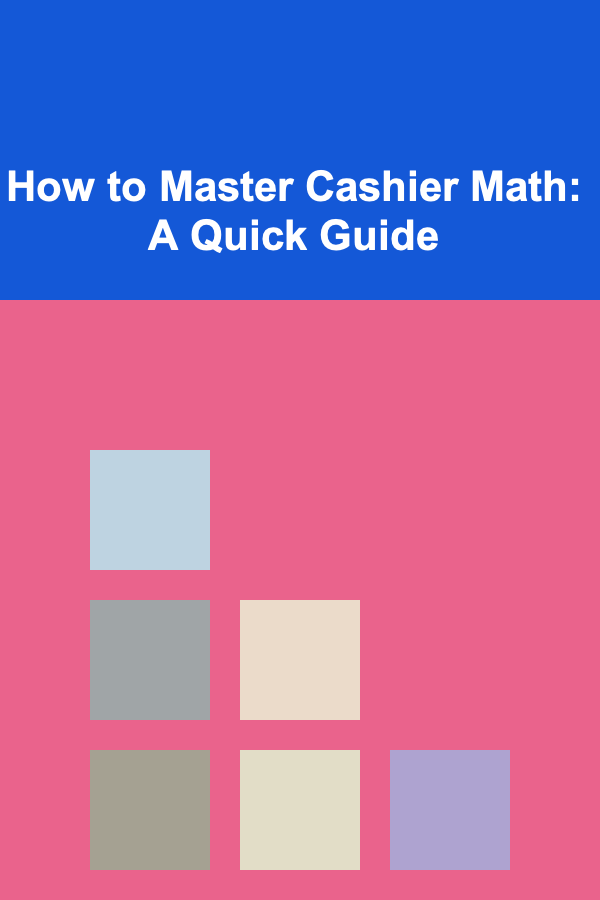
How to Master Cashier Math: A Quick Guide
ebook include PDF & Audio bundle (Micro Guide)
$12.99$9.99
Limited Time Offer! Order within the next:

Cashier math is an essential skill for those working in retail or customer service. As a cashier, your primary responsibility is handling transactions, which often involves quickly calculating prices, making change, and ensuring accurate payments. Mastering cashier math can boost efficiency, reduce errors, and improve customer satisfaction. In this article, we will explore effective methods and strategies to master cashier math, ensuring you're always prepared to handle any situation behind the register.
Understanding Basic Math Operations
At the core of cashier math is a solid understanding of basic mathematical operations: addition, subtraction, multiplication, and division. As a cashier, you'll frequently use these operations to calculate total costs, give correct change, and process discounts or taxes. Let's break down each operation:
- Addition: Adding the cost of individual items to determine the total price of a transaction is a common task. This involves adding up the prices of multiple items, taxes, or discounts.
- Subtraction: Subtraction is essential for calculating discounts, subtracting returns, or giving back the correct amount of change when a customer overpays.
- Multiplication: This comes in handy when calculating totals for multiple items of the same price or applying percentage-based discounts (e.g., 20% off).
- Division: Division is crucial when dealing with sales tax percentages, splitting the cost of multiple items, or calculating per unit prices.
Getting comfortable with these operations and understanding their application is the foundation of cashier math.
Learn to Calculate Prices and Taxes Quickly
In most cases, the total price of items is calculated by adding the individual item prices. However, you also need to consider taxes, which vary based on location. Depending on where you are working, taxes can be calculated at the point of sale and added to the total. To master cashier math, follow these steps:
Adding Sales Tax
To add tax to a price, follow these steps:
- Step 1: Convert the tax rate into a decimal. For example, a 7% tax rate would be 0.07.
- Step 2: Multiply the price of the item by the tax rate. For example, if an item costs $50 and the tax rate is 7%, multiply $50 by 0.07 to get $3.50.
- Step 3: Add the tax to the original price. In this case, $50 + $3.50 = $53.50.
Using the Tax-Exclusion Method
Alternatively, you can use the tax-exclusion method, which is helpful when dealing with discounted items. This involves calculating the price before tax and then adding the tax. For example, if an item is priced at $50 and the tax rate is 7%, the total price can be calculated as:
- $50 ÷ (1 + 0.07) = $46.73 (price before tax)
- Tax: $50 - $46.73 = $3.27
- Total price after tax: $50.00
Be sure to practice these steps regularly to increase your speed and accuracy.
Making Change Like a Pro
One of the most important aspects of cashier math is making change accurately and efficiently. This skill is essential to providing a smooth customer experience. Here's how to handle change:
Step 1: Count Up to the Total Amount
Instead of subtracting the amount tendered from the total, use the counting-up method, which is quicker and reduces the chance of error.
For example, if a customer hands you $20 for an item costing $13.75, you would count up from $13.75 to $20:
- $13.75 + $1.00 = $14.75
- $14.75 + $5.00 = $19.75
- $19.75 + $0.25 = $20.00
The customer should receive $6.25 in change.
Step 2: Know the Denominations
Familiarize yourself with the coin and bill denominations you are working with. Knowing the different combinations of coins and bills helps speed up the process of making change. The most common coins are:
- Pennies (1 cent)
- Nickels (5 cents)
- Dimes (10 cents)
- Quarters (25 cents)
And the most common bills are:
- $1
- $5
- $10
- $20
- $50
- $100
Step 3: Avoid Over-Calculating
When making change, avoid calculating unnecessary amounts. For example, if a customer pays with a $20 bill, you don't need to calculate the total amount of change using smaller coins unless required. Stick to counting up from the total price to keep things efficient.
Handling Discounts and Promotions
Discounts and promotions are frequently used in retail to attract customers. As a cashier, you need to quickly and accurately apply these discounts to ensure proper pricing.
Percentage-Based Discounts
To calculate a percentage-based discount, follow these steps:
- Step 1: Convert the percentage into a decimal. For example, a 20% discount becomes 0.20.
- Step 2: Multiply the price of the item by the decimal to find the discount amount. For example, a $50 item with a 20% discount would be $50 × 0.20 = $10.
- Step 3: Subtract the discount from the original price. $50 - $10 = $40.
Fixed Amount Discounts
For fixed amount discounts (e.g., $5 off), simply subtract the fixed amount from the price.
- Example: $50 - $5 = $45.
Buy-One-Get-One Free or Multi-Buy Discounts
Sometimes, stores offer promotions like "Buy One, Get One Free" or "Buy Two, Get One 50% Off." In these cases, calculate the total price by considering how many items are purchased and how the promotion works.
For example, for a "Buy One, Get One Free" promotion, if you buy one item for $30 and get a second for free, the total cost would be $30.
Mastering Large Numbers and Quick Multiplication
As a cashier, you may sometimes need to handle large numbers, especially when dealing with bulk purchases or pricing large quantities of the same item. To handle these situations efficiently:
Step 1: Use Mental Math Techniques
While calculators are helpful, it's important to develop the ability to perform quick multiplication and addition in your head. Practice multiplying items quickly in your head to speed up your register operations.
For example, to calculate the total for 10 items priced at $15 each:
- $15 × 10 = $150
Step 2: Break Down Large Numbers
If you're faced with a more complex calculation, break it down into smaller, easier parts. For instance, to calculate 12 items at $22.50 each:
- $22.50 × 10 = $225
- $22.50 × 2 = $45
- Total: $225 + $45 = $270
Breaking the calculation into parts makes it easier to handle mentally.
Staying Organized During Transactions
Keeping your workspace organized can improve the efficiency of your math calculations. Follow these tips to stay organized during transactions:
- Keep track of discounts and offers: Always ensure you know the current store discounts and promotions to apply them correctly.
- Be mindful of price overrides: In case of errors or price adjustments, be prepared to make quick price overrides and adjustments in the system.
- Stay calm under pressure: Cashier math can become overwhelming during peak hours. However, staying calm and organized will help you maintain accuracy and speed.
Practice, Practice, Practice
Like any other skill, cashier math improves with practice. Set aside time each day to practice your math skills, whether it's through mental math exercises, using calculators, or performing quick calculations during mock transactions.
Conclusion
Mastering cashier math is about more than just knowing basic math operations---it's about improving your efficiency, accuracy, and confidence when working behind the register. By practicing basic operations, handling taxes and discounts quickly, and learning how to make change accurately, you'll enhance your ability to serve customers effectively.
As a cashier, being able to perform math quickly will make your job easier, reduce stress, and provide better service to customers. With time, practice, and experience, you'll become proficient at handling all types of transactions with ease and precision.
Reading More From Our Other Websites
- [Personal Investment 101] The Top Deep Learning Business Ideas That Can Make You Money
- [Screen Printing Tip 101] Best Screen Printing for Eco‑Friendly & Sustainable Apparel Production
- [Home Budget Decorating 101] How to Decorate with Budget-Friendly Home Accessories
- [Home Maintenance 101] How to Maintain Your Home's Home Theater and Audio Systems
- [Organization Tip 101] How to Involve Family and Friends in Time Capsule Creation
- [Personal Care Tips 101] How to Enhance Your Mascara Routine with Lash Primer
- [Home Lighting 101] How to Use Outdoor Lighting to Enhance Your Backyard
- [Personal Investment 101] How to Manage Your Investment Property Efficiently
- [Personal Finance Management 101] How to Invest in Index Funds for Beginners
- [Biking 101] How to Choose the Perfect Women's Bike for Your Ride

How to Incorporate Modern Design Elements in Your Home Renovation
Read More
How to Make Money from Data Using Deep Learning Techniques
Read More
How to Understand and Use Index Funds for Long-Term Investment
Read More
How to Understand Tokenomics
Read More
How To Build a Thriving Small Business Empire
Read More
10 Tips for RV Trip Planning on a Budget
Read MoreOther Products

How to Incorporate Modern Design Elements in Your Home Renovation
Read More
How to Make Money from Data Using Deep Learning Techniques
Read More
How to Understand and Use Index Funds for Long-Term Investment
Read More
How to Understand Tokenomics
Read More
How To Build a Thriving Small Business Empire
Read More